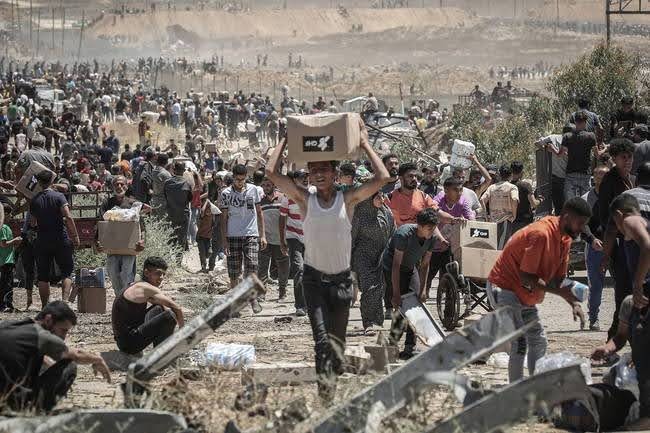“Death Traps”: How Israel Uses Gaza Aid Centers to Lure and Kill Starving Civilians
Israel turns Gaza aid centers into “death traps,” killing hundreds of starving Palestinians under the guise of humanitarian relief through the U.S.-backed “Gaza Foundation.” This report exposes systematic massacres and international calls for accountability.
NEWS
Refaat Ibrahim
6/29/20253 min read


Since late May 2025, aid distribution points across the Gaza Strip have transformed into scenes of mass killings. In one of the most brutal policies deployed by Israel during its ongoing war of extermination since October 2023, the so-called “Gaza Humanitarian Foundation,” supported by both the U.S. and Israel, has become a deadly facade for orchestrated crimes under the cover of humanitarian aid.
A Systematic Starvation Policy
From day one of the war, Israel implemented a severe starvation policy against Palestinians in Gaza. It closed all crossings, banned the entry of food and medicine, and reports documented people resorting to eating leaves and drinking saltwater to survive. The blockade intensified further with Israel’s renewed assault on Gaza in March 2025.
This was not coincidental. Multiple Israeli ministers, including National Security Minister Itamar Ben-Gvir and Finance Minister Bezalel Smotrich, publicly urged the government not to allow humanitarian aid into Gaza, citing fear of it reaching Hamas. However, the real victims were starving civilians.
The “Gaza Foundation”: Humanitarianism Behind the Barrel of a Gun
In February 2025, the United States announced the launch of the Gaza Humanitarian Foundation, allegedly to provide aid to civilians while “ensuring it doesn't fall into the hands of Hamas.” However, the real implementation on the ground told a starkly different story.
By the end of May, the foundation opened two distribution centers, one in Rafah in southern Gaza and the other near Wadi Gaza in the central region. On its first day of operations, thousands of starving Palestinians lined up desperately for flour and supplies.
Instead of receiving food, they were met with live gunfire from Israeli soldiers, resulting in deaths and injuries. This was the beginning of a pattern: mass killings under the pretense of food aid, earning these sites the grim nickname Death Traps.”
A Trail of Massacres Masquerading as Relief
Official statistics and rights groups’ reports document the unfolding tragedy:
May 27, 2025: Israeli forces opened fire on civilians at the Rafah center, killing 3 and wounding 46.
May 28: Another massacre in Rafah left 10 dead and 62 injured.
June 1: 35 were killed in Rafah and one in Wadi Gaza; over 200 were injured.
June 2–3: Another 53 civilians killed and 182 wounded.
June 6–12: Over 130 dead and 934 injured, including victims in Rafah and Wadi Gaza.
June 13–17: A terrifying escalation, 147 Palestinians killed, nearly 900 injured. In Khan Younis alone, 51 starved civilians were killed by Israeli artillery.
June 18–21: An additional 71 Palestinians killed and 300+ injured while queuing for food near Netzarim and Wadi Gaza.
These are not isolated “mistakes.” The repetitive pattern, the targeting of specific aid centers, and the timing indicate a premeditated strategy aimed at luring starving civilians to exposed locations and eliminating them.
Global Condemnation and Accusations of Genocide
International outcry followed quickly. In mid-May, the Euro-Med Human Rights Monitor stated that the U.S.-Israeli aid model operated by the Gaza Foundation was nothing short of a "death trap" scheme designed to lure civilians to kill zones as part of Israel’s genocide campaign.
The United Nations Relief and Works Agency (UNRWA) also declared that the current aid distribution model "humiliates the needy and strips them of their humanity," turning aid lines into battlegrounds.
On June 3, 2025, UN Secretary-General António Guterres demanded an immediate, independent investigation into the massacres, stating:
“It is unacceptable that Palestinians must risk their lives for food.”
He stressed that Israel has clear legal obligations under international humanitarian law to allow and facilitate the delivery of aid.
U.S. Involvement: A Humanitarian Mask for Military Crimes
A particularly damning aspect of the crisis is the direct coordination between the Gaza Foundation and the Israeli military. Not only were aid sites pre-selected and openly exposed, but eyewitnesses reported seeing armed guards from American private security firms aiding in crowd control, often using live fire.
The Government Media Office in Gaza went as far as describing the foundation as
“A propaganda tool in the hands of the Israeli military used to complete the genocide under a humanitarian disguise.”
Beyond a Crisis: A Moral and Legal Catastrophe
Under international law, the use of starvation as a weapon against civilians is classified as a war crime. What is occurring in Gaza, however, surpasses that. This is not simply about denial of food; it’s about weaponizing food distribution itself to lure civilians into death traps.
If confirmed, this would represent a fully orchestrated crime where humanitarian aid is used as bait, and death is the outcome. That would not only violate the Geneva Conventions but also constitute crimes against humanity under international law.
Between Hunger and Gunfire: A Population Under Siege
Trapped between starvation and gunfire, Palestinians in Gaza face an impossible choice: stay home and die slowly or seek food and risk being shot. In this cruel equation, even the basic human right to survive is criminalized.
What’s unfolding in Gaza today is not just a humanitarian disaster; it’s a global moral test. Will the world allow the continued use of food aid as a weapon of war? Or will the veil finally fall, exposing the truth behind the so-called humanitarian narrative?
This is no longer about food. It’s about dignity, accountability, and whether the international community will act before more lives are lost not by hunger, but by bullets fired in the name of aid.
Awareness
Documenting reality, amplifying Palestinian voices, raising awareness.
Contact Us:
resistant.p.pens@gmail.com
Follow our social media
